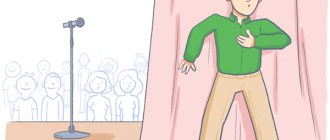Didn’t they tell you as a child: “Well, why are you frowning? Smile!”, and you were still distantly looking at the world around you from under your forehead, hanging on your mother’s hand. Everything is extremely simple: a sullen appearance reveals your mood and facial expression. We often notice the smiles on the faces of our interlocutors. Welcoming and warm - it can evoke a positive reaction to the person smiling; it can express understanding and sympathy, emphasize sarcasm or dissatisfaction. You can’t imagine how many types of smiles there are and what different meanings they have.
Psychologists have repeatedly noted that by a smile you can recognize not only a person’s mood, but also his character, inclinations, and personality type. Unconsciously, each of us can distinguish a smile “sarcasm” from “I’m so glad to see you,” but this is only a small fraction of all types of smiles and their meanings in psychology.
From this article you will learn what most smiles mean, and you will easily be able to assess the reaction of your interlocutors to you and others.
Sincerity
Did it seem to you that the person smiling at you was somehow unfriendly and insincere with you? In most cases, this is true. Our subconscious independently evaluates a smile, facial expressions, curves and sends a signal of sincerity. It is very easy to distinguish a forced smile, as psychologists report. Pay attention to your mouth muscles and eye movements. Of course, we can put on a smile, but moving pupils are difficult to control, especially at the moment of lying or insincerity. With a sincere smile, the muscles of the mouth stretch, corners form, teeth are exposed, and the eyes narrow, forming wrinkles. A sincere smile is always honest because it occurs automatically and unconsciously.
An insincere “brow” is asymmetrical, most often one side is more curved than the other, and the eyes do not narrow. If a person smiles only with his lips, he is being dishonest with you. You can see this type of smile in a photo when the photographer asks you to smile or says “cheese.”
Thus, to find out whether a smile is sincere, it is enough to pay attention to the eyes. Be careful with this type of smile: if the fake “brow” is too wide, due to the raised cheeks, you may think that the eyes have become narrower. In this case, pay attention to the symmetry of the eyebrows; a sincere smile lowers the tips of the eyebrows down.
Secrets and mysteries of a smile
Among the variety of non-verbal means of communication, the smile occupies a special place. This is due not only to the role it plays in communication, but also to its amazing features.
A smile is a facial movement that can involve up to 53 facial muscles. And if you remember that there are 57 facial facial muscles, you understand how complex this movement is and how diverse a smile can be. In addition, the eyes are involved in this facial reaction - their expression is very important for understanding the essence of a smile.
It is traditionally believed that it expresses positive emotions: joy, pleasure, happiness. However, in the process of long evolution, the smile has acquired many types and meanings, and in modern man it often expresses rather contradictory emotions. For example, it is difficult to describe in a few words what feelings a sad, mocking, angry or tragic smile conveys. What does a person feel when he smiles doomedly? Hardly positive emotions. A person’s ability to convey through a smile a variety of feelings that are difficult to describe is one of the mysteries of this complex facial reaction.
Considering the complexity, you might think that learning to smile is very difficult and requires years of practice. But that's not true. Children begin to smile literally in the first weeks after birth, although, of course, many types of this facial reaction are mastered only by adults. Fortunately, our kids are incapable of sarcastic, contemptuous, or evil smiles.
Smiling does not need to be learned, because it is an innate expressive reaction. Even higher animals can smile: dogs, horses, dolphins, monkeys, etc. Expressive reactions arise as a manifestation of experienced emotions. A person has many of them, for example, redness of the skin, dilation and constriction of the pupils, tremors - trembling of the limbs, goosebumps on the skin, etc.
Expressive reactions are reflexive in nature, and a person cannot control them, voluntarily evoke or suppress them. So, we are not able to sweat or blush at our own request; our pupils also completely involuntarily dilate from fear and constrict from anger.
But the smile is unique. It is so important for a person that he has learned to control this reflex reaction. The importance of a smile in a person’s life is confirmed by the variety of its functions.
Smile “at 32” or pursed lips
An open or closed smile is the most obvious and extremely simple classification. The type of smile depends on the temperament of the individual, on the atmosphere in which communication takes place. Some people smile only with their lips, while others smile with all their 32 teeth. It is difficult to tell about a certain mood from such a smile; rather, such a classification will help determine the temperament of the person talking to you.
More often than not, people who don't show their teeth are the control type. This type is stingy with emotions, often suppressing them until they disappear completely. Such smiles are often mistaken for a contemptuous grimace rather than a sign of sincere sympathy for you. Such people, a priori, should not be trusted. Have you noticed that the person talking to you makes promises with pursed lips? Know that he is unlikely to be sincere; most likely, he is talking to you for his own benefit.
The opposite type of people, with an open smile, are more sincere and relaxed around you. He is sensitive and knows how to win over. You can easily trust such people, but do not forget how to distinguish sincerity, because there are plenty of open fakes. The eyes will help you, a sincere open smile is accompanied by glowing, joyful eyes.
#7 Eat, Laugh, Love - Confidently: Smiling Styles
1. Spike (commissural) style
, it is possessed by more than half of the population. It is characterized by raising the corners of the mouth upward and to the sides, following the levator muscle of the upper lip, ending with the exposure of the upper teeth. The lower edge of the smile runs along the incisal edge of the upper central incisors. People with a commissure smile style: Frank Sinatra, Jennifer Aniston, Jamie Lee Curtis, Audrey Hepburn.
2. Canine style (“lip bend”)
occurs in a third of the population.
The shape of the lips when smiling resembles a diamond. Characterized by the display of fangs, then the corners of the mouth rise up and stretch to the sides. Often the corners of the mouth remain below the maxillary canines. A smile like this on a woman’s face is considered the most attractive. The canine style also has a more poetic name - “gull wing”. People with this style of smile: Elvis Presley, Tom Cruise, Drew Barrymore, Sharon Stone, Linda Evangelista. 3. Mixed style
, it is possessed by 2% of the population. The shape of the lips when smiling looks like two parallel chevrons. The levator labii superioris and anguli oris and the depressor labii inferioris muscles work simultaneously to expose both the upper and lower teeth. The shape of the lips is usually illustrated as two parallel red stripes. People with mixed smile styles: Julia Roberts, Marilyn Monroe, Will Smith, Oprah Winfrey. Often the shape of a smile can be determined by a habit or the location of the hard tissues of the oral cavity. Smile restoration can help the patient overcome long-standing problems and also increase attractiveness.
There are 4 stages of the smile cycle:
I. Lips are closed. II. Half-smile (lips are relaxed, but the corners of the mouth are slightly raised up). III. Natural smile. IV. Wide (full) smile. Of course, the types of smiles vary and are unique to each person. If the smile is not wide, you can limit yourself to restoring the front of the six upper teeth. If stage 4 is present, then recovery should be appropriate. Varieties There are 5 variations in the external characteristics of a smile, which depend on the presence of hard and soft tissues in the “smile zone”
Type 1. Only the upper teeth (or part of them) are visible. View 2. The upper teeth and more than 3 mm of gums are visible. View 3. Only the lower teeth (or part of them) are visible. View 4: Both upper and lower teeth are visible. View 5. Neither the upper nor the lower teeth are visible. In most cases, a person falls strictly into one of these varieties, however, if necessary, types can be combined. For example, a patient may have a mixed smile in which both the upper and lower teeth are visible, as well as more than 3 mm of gum tissue. This unusual style of smile corresponds to both the 2nd and 4th types. Smile Classification System The above categories can be combined to create a structure that objectively describes the different types of smiles. Style, stage and appearance together provide a complete, easy and concise description. This classification is useful for both the dentist and the patient. For example, the most common smile has the following code: commissure (style 1), stage III, type 1. And although “smile therapy” is still in its infancy, society is already demanding dentists not just treat teeth, but turn them around. attention to the appearance of each individual patient. The smile classification scheme presented in the article can help when the patient and dentist discuss variations of further aesthetic treatment. Let's take a closer look at what this or that type of smile reveals to the eye. The shape and color of teeth is an important image component of the beauty and attractiveness of the face. It is noticed that the teeth of every person correspond to the face. If the face shape is oval, then the shape of the teeth is most often oval. A triangular or square face is “attached” with teeth corresponding in shape. Yellow color or pigment spots on teeth cause great harm to aesthetics. Fluorosis, caused by an increased fluoride content in water, often leads to the appearance of stains. The process goes under the enamel, and removing these stains is quite difficult. In this case, remineralization therapy is carried out, but more often the outer layer of teeth is replaced with veneers or crowns. Many people believe that the distal chewing groups of teeth are not necessary in life, because you can train yourself not to smile openly. In this case, you need to constantly monitor how the face looks, which limits openness, communication opportunities and harms the entire dental system. After all, when there is no chewing group, the frontal, visible group of teeth bears an increased load. This entails its loss, because it is adapted to perform a biting rather than a chewing function. Of course, aesthetics can be restored using various types of prosthetics, and we talked about this in previous issues of our newspaper.
Manufacturing of prostheses
is a great art associated with the enormous limitations that exist in the oral cavity: the presence of a certain number of teeth, the height, width and thickness of each tooth, its correspondence to its anatomical shape, its position and color, its closure with antagonist teeth, its location in relation to to the muscles of the lips. The dentofacial system is so balanced and precise that an overestimation of the distal part of the chewing group of teeth by literally 0.01 mm makes it impossible to close the teeth in the frontal area by up to half a centimeter. If you put a crown on the 7th tooth, and it will overestimate it by 0.01 mm, then in the frontal area the patient’s mouth may not close as thick as a cigarette, which he will not be able to hold between his teeth. At the same time, there are a huge number of aspects when the lack of understanding of the patients themselves interferes with a better result. Not quite imagining what will come of this, some try to influence the doctor and make their teeth lighter or smaller or larger. This can lead to a result that says artificial teeth. And when it is clear that the teeth are artificial, we can conclude that the professional quality of the prosthetics is very low. And, unfortunately, this situation still prevails in our country.
Half smile
More often it is taken as a sign of contempt and is slightly mistaken. Such a smile rather speaks of arrogance. This species belongs to manipulators and seducers, one of the most dangerous types.
Would you like to know something about yourself? Smile! First with the left corner of the lips, then with the right. Which corner looks more natural on you? Left suggests that you are a mocker, and you are also prone to spontaneously arising emotions. This is explained by the fact that the left half belongs to the hemisphere responsible for our emotions.
And the right corner says that you, comrade, are a cynic! Cynics are tougher, they are often able to notice all his interlocutor’s shortcomings, and are often fueled by bitterness. They are not subject to enthusiasm and avoid entertainment. But they have excellent resistance to frustration.
Mockery
A typical sarcastic smile is one where the corners of the mouth begin to move towards the ears, creating what are called mocking dimples. A person who mocks rarely has respect or empathy for anyone, so it is not surprising that it is most common among criminals and the mentally ill.
He wrote many books that became bestsellers: Around the World by Bicycle
Mulching with cardboard: how to remove wheatgrass and hogweed in the garden without chemicals
Elena has a difficult character: what is the secret of Anton Khabarov’s happy family
Child's smile
This type of smile can also be called naive. Pay attention if your interlocutor sends you such a smile. The trace of a child's soul is clearly visible in her. Probably, such a smile can be put on par with a sincere, childishly warm smile. A naive smile can brighten up a gray mood, reduce the intensity of passions, and shelter from anxiety.
Unfortunately, people with a naive smile are easy to manipulate; they are very impressive, childishly trusting and compassionate.
Smile!
Remember that your smile is not only an indicator of your mood, but also a powerful weapon that will help you more than once in your future life.
A smile will help to seduce, attract, win over, and repel. A real smile seems to light up your face. A pleasant curve of the lips and slightly exposed teeth will help express your feelings and impressions.
Hone your charming smile with various exercises and gymnastics for the facial muscles (psychotonic gymnastics). By training, exercising your muscles and studying the meanings of different types of smiles, you will become the owner of not only the most charming, sincere and attractive smile, but also get your hands on a weapon that can work better than hypnosis. This gymnastics is very simple and very useful.
This is such an interesting psychology and types of smiles. No matter how many variations of smiles there are, remember, if you want to win someone over, use only a sincere, friendly smile: they are the most welcoming, seductive and warm.
We believe that in the future, knowledge about the types of smiles and their meanings will be useful to you; with it, you will easily determine the hidden reactions of people and learn to win over you. Smile more often, only sincerely.











